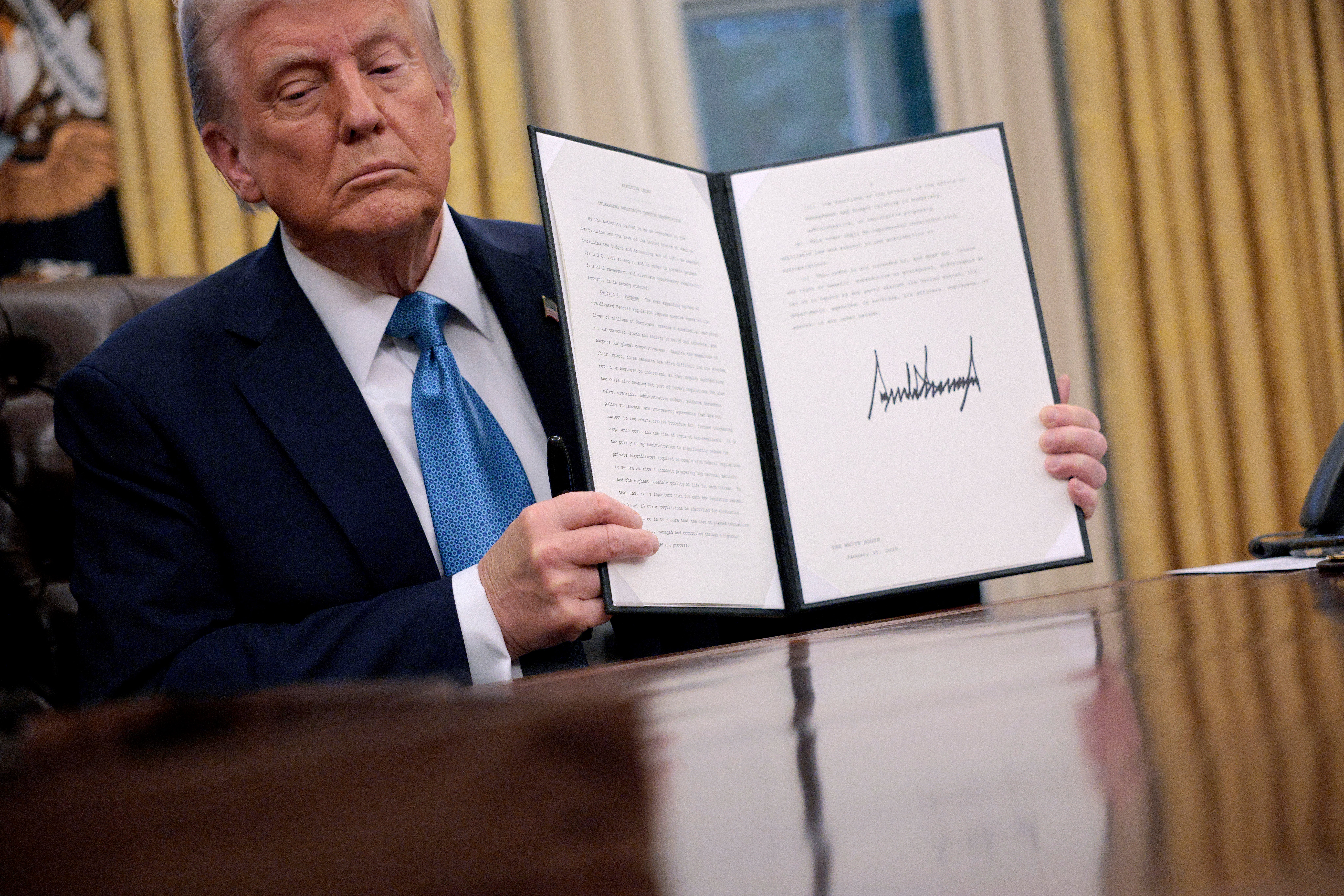I’ve written a book on the science of racism – this is what facts say about whether DEI works
Goldman Sachs and Deloitte are the latest major corporations to revise their policies in response to Donald Trump's push against diversity initiatives. Here, Professor Keon West unravels the myths and uncomfortable truths about inclusion policies in the workplace

On 21 January 2025, Donald Trump issued an executive order restricting diversity, equity, and inclusion (DEI) training in federal agencies. These orders were framed as necessary measures against “dangerous, demeaning” concepts, and claimed that the scrapping of DEI initiatives would help foster a workplace in which all Americans are treated with equal dignity and respect.
These were bold moves, and they are having seismic effects in the workplace in America and around the world. They’ve sparked a flurry of headlines declaring the “end of the wokeplace”, with Trump seen as a champion of flushing out a “liberal woke-mind virus”.
Most recently, Goldman Sachs and Deloitte have joined the growing list of corporate giants adjusting their policies in response to Trump’s anti-diversity agenda.
The banking giant has eliminated a policy designed to promote diversity on the boards of companies it takes public. Under the 2020 policy, Goldman Sachs had required that any company seeking an initial public offering include at least one board member from a diverse background.
Elsewhere, the orders have already cost many real people the jobs they needed to survive. Admiral Linda Fagan, the first woman to lead the United States Coast Guard, was sacked as an apparent “DEI hire”. The White House announced that federal DEI workers were being placed on paid leave, and a rollback of DEI efforts at Walmart, and of course Zuckerberg’s Meta and Bezo’s Amazon, happened almost immediately.
As jobs were put at risk, hosts and guests on conservative cable news networks celebrated. “Bye, Bye, DEI,” posted Fox News on Instagram.
As a visiting professor and social psychologist at the London School of Economics and Political Science, I wanted to look beyond the headlines and to the facts. Given the consequences of this executive order, how much of this, if any, is based on science and how much of it is misguided destruction in the service of unhelpful culture wars?
Is Trump on to something?
As the saying goes, even a stopped watch is right twice a day, and it would be dishonest to ignore the things that Trump has got right – things that are of increasing concern even among those who broadly support DEI work and want it to be more effective.
It is true, for example, that DEI’s track record of successfully improving diversity and inclusion is, to be frank, inconsistent. Some DEI efforts have positive effects. However, studies of hundreds of companies over numerous decades, such as the work of sociologists Frank Dobbin and Alexandra Kalev in 2006, have found that several popular staples of DEI work have no discernible effects at all. They have even found that certain interventions, like mandatory unconscious bias training, actually decrease the proportions of women and ethnic minorities in management positions, possibly due to backlashes against the training and a lack of other systems to support it.
One 2013 study entitled Presumed Fair: The Ironic Effects of Organisational Diversity Structures shows that some DEI work even functions to protect companies from consequences or reputational damage, allowing them to continue discriminatory practices with impunity. Research like this feeds concerns that some companies’ handbooks on diversity and inclusion are useful distractions from ongoing racist and sexist behaviours, asking us all to “pay no attention to the man behind the curtain”.
All this while DEI initiatives have vastly proliferated over the past few decades, creating a business worth over $8bn a year in which almost every person in every workplace, including me (and probably including you), has been made to take part.

Trump’s problem with DEI doesn’t mean he has the answer…
Here, unfortunately, is where any praise for or agreement with the president’s executive order must end. The order will not, as it claims, “protect individual Americans from discrimination based on race, colour, religion, sex, or national origin”. It will not “benefit all Americans”. It will not undermine or prevent “dangerous, demeaning, and immoral race- and sex-based preferences”.
It will not encourage “the traditional American values of hard work, excellence, and individual achievement”. It will not prevent “hardworking Americans” from being “stigmatised, demeaned or shut out of opportunities because of their race or sex”. It absolutely will not “[restore] merit-based opportunity” or “[support] equality of opportunity for all Americans”.
Why? Because these claims are, from a scientific perspective, unmitigated nonsense. According to all available scientific research, Trump’s order will accomplish exactly none of those things and will almost certainly exacerbate the very problems it claims to solve. To understand why, we must understand the many important facts that Trump’s order ignores.
Reframing the question
I am not shy to call out the limitations, weaknesses, and costs of our current DEI efforts. Indeed, I devote an entire chapter of my book The Science of Racism to these issues. I did this because I really want people to understand the serious action that is required to address the shortcomings of DEI in its current form. And, I want people to understand why, despite my full awareness of these shortcomings, I have continued to do DEI work, and still consider it absolutely necessary.
The real power of propaganda is not that it tells you what to think about things, but that it tells you what things to think about. As another saying goes: “If they can get you to ask the wrong questions, the answers will not matter”.

Trump’s orders are very much grounded in the question of whether DEI efforts are unfair to men and White people, showing favouritism to women and ethnic minorities – a question that is outlandishly out of sync with all available facts. From the admissions department of elite education establishments to highly coveted jobs in the workplace, it has been increasingly common to hear the refrain “the one thing you don’t want to be today is ‘White, male and middle-class’”. But, even the smallest investigation of this claim proves it to be completely wrong.
Quite the contrary, science is remarkably clear on whether and against whom contemporary workplaces are unfair, and (surprise!) it isn’t men and White people. For decades, researchers have been conducting studies in which they test for hiring discrimination according to race and gender.
Scientists have, for example, made hundreds or thousands of copies of CVs with identical qualifications and experience, varying only the demographic characteristic of these CVs (eg, changing the names to make it seem like they are being sent by White people or by Black people). With shocking reliability, repeated studies paint the same picture - that despite the supposed applicants being exactly equally qualified, the “White” applicants are significantly more likely to be interpreted as professional, legitimate and likeable. Another study in 2020 showed that despite the supposed applicants being exactly equally qualified, the “White” applicants are significantly more likely to be interpreted as professional and, in 2019 researchers found they are more likely to receive calls to interview or offers of employment.
Across the board, studies find these gaps to be enormous, with studies spanning from 2009 to 2019 showing White people sometimes receiving over twice as many callbacks or job interviews as equally qualified ethnic minorities. Similarly, research on gender discrimination shows that men are perceived as more competent and hireable and treated much more favourably than women who are exactly as qualified as they are. Nothing that has ever been done in American society has ever eliminated these unfair advantages for men and White people and nothing, absolutely nothing, including DEI, has reversed them.
In light of these scientific facts, Trump’s questions about DEI being unfair to men and White people are not only the wrong questions, but Orwellian distractions from the real issues.
If Trump was truly concerned with promoting a real meritocracy – the right question would have to be something along the lines of “what is the best way to address the scientifically proven bias against women and ethnic minorities in the workplace?” Or perhaps, even, “what strategies other than DEI could we employ to reduce the scientifically proven racism and sexism in the workplace?”

These are the questions that could potentially take us toward a place which, as Trump’s executive order put it, could “protect individual Americans from discrimination based on race, colour, religion, sex, or national origin”.
If DEI is broken – what could fix it?
In light of these questions, the scrapping of all DEI work can be seen for what it truly is, a regressive policy that will serve to protect and perpetuate the scientifically proven non-meritocracy in which men and White people receive unfair advantages over equally qualified women and ethnic minorities.
Of course, this is not to say that there are no effective options. Quite the opposite: scientific research is replete with actions that can make immediate, enduring, measurable, and sizable reductions in the bias of our workplaces. Intergroup Theory is one of them. Psychologists Thomas Pettigrew and Linda Tropp from University of California and Boston College, conducted a meta-analytic test of over 500 independent studies and found when groups interacted with others different to themselves (eg across racial groups) in conditions which were positive and meaningful, it was an incredibly reliable strategy to reduce prejudice. Another study in 2012 devised and successfully tested an intervention using techniques, like stereotype replacement and counter-stereotypic imagery, that measurably reduced implicit bias for months.
Furthermore, other studies have shown that not all strategies depend on changing people’s biases. Nor should they. Dobbin and Kalev’s work on diversity practices has shown that the most effective strategies rely on transparency and accountability. When managers and selection committees are forced to justify their choices, bias was found to be less present in those choices. There are many such strategies that rely less on making any individual less biased and more on changing the systems in which these biases are allowed to flourish and affect outcomes.
Trump’s hostility toward DEI remains a rallying point for many on the right and the Trump effect is already being felt in other countries, notably in the UK. A war on “woke” is being particularly indulged by Badenoch and Farage, who have all suggested that it is time that Britain woke up and reversed the DEI juggernaut.
But, if history and science have taught us anything, it’s that ignoring prejudice does not make it disappear. If anything, policies that suppress DEI efforts only entrench the very meritocratic disparities they claim to oppose. Even if we are expected to believe that Trump’s executive orders were designed to protect American workers, as he claimed, the fact is that they will achieve precisely the opposite. To deny that is not just politically expedient commentary – it is scientifically indefensible.
The Science of Racism: Everything You Need to Know but Probably Don't – Yet by Professor Keon West is out now



Join our commenting forum
Join thought-provoking conversations, follow other Independent readers and see their replies
Comments